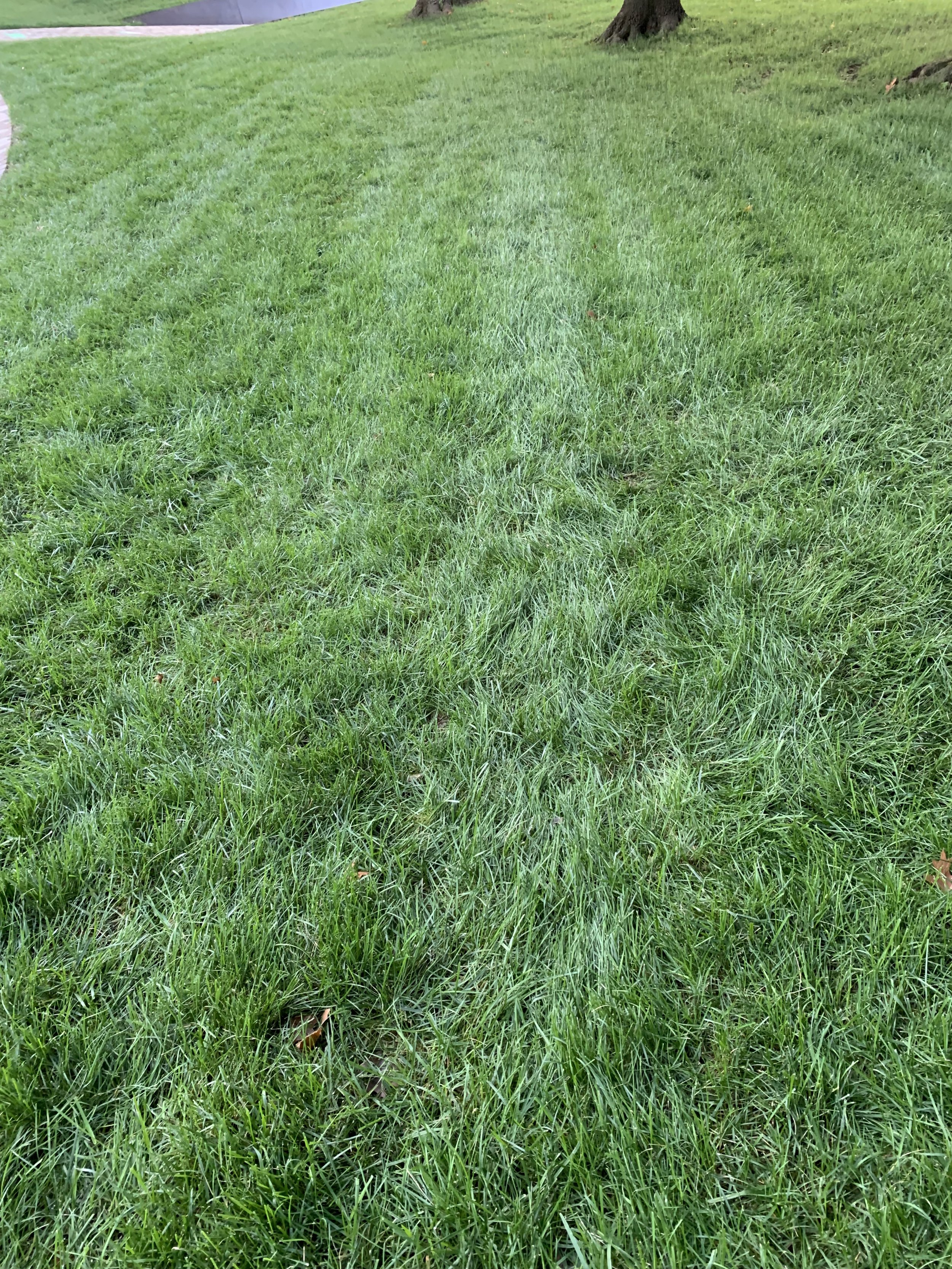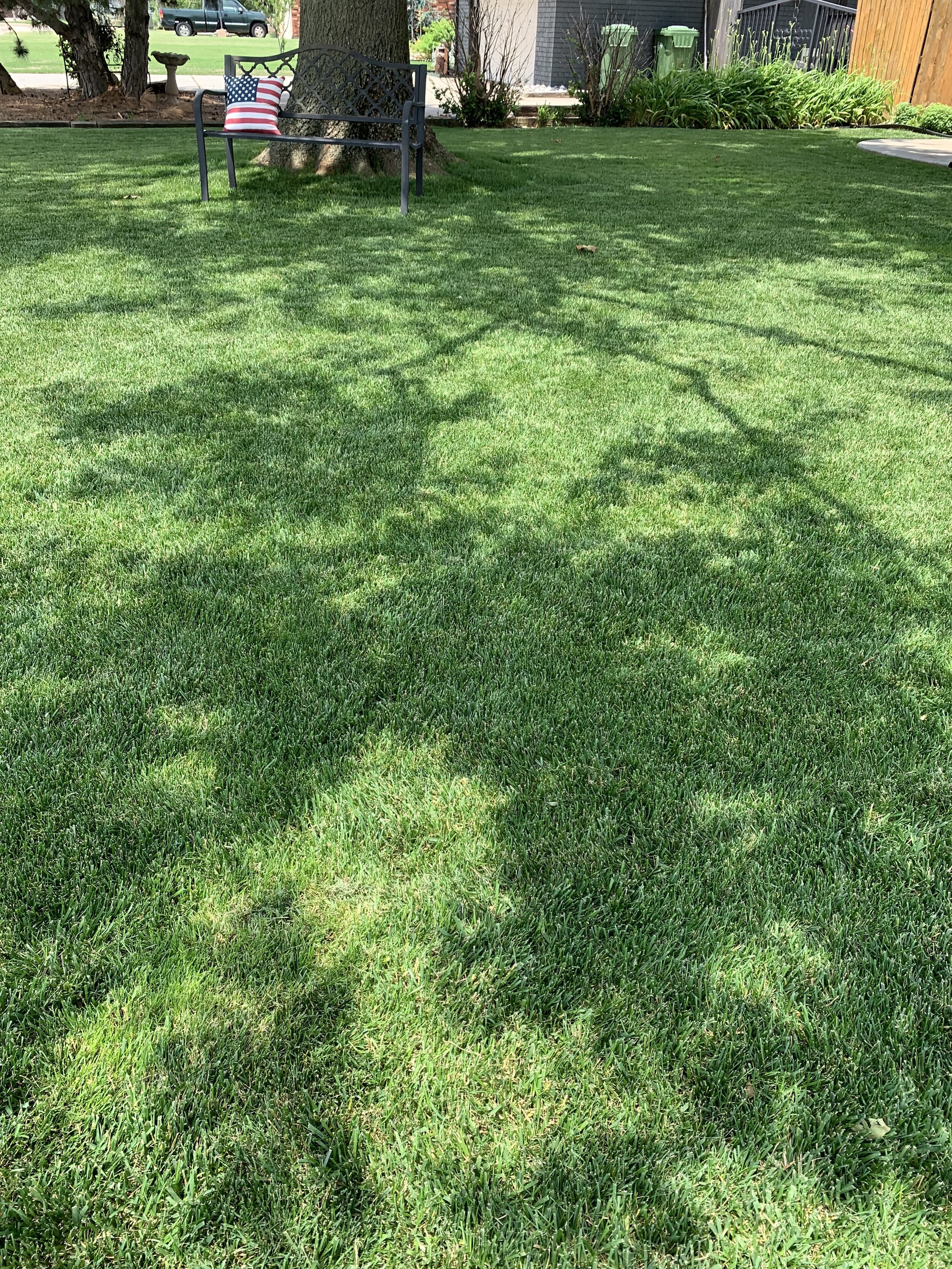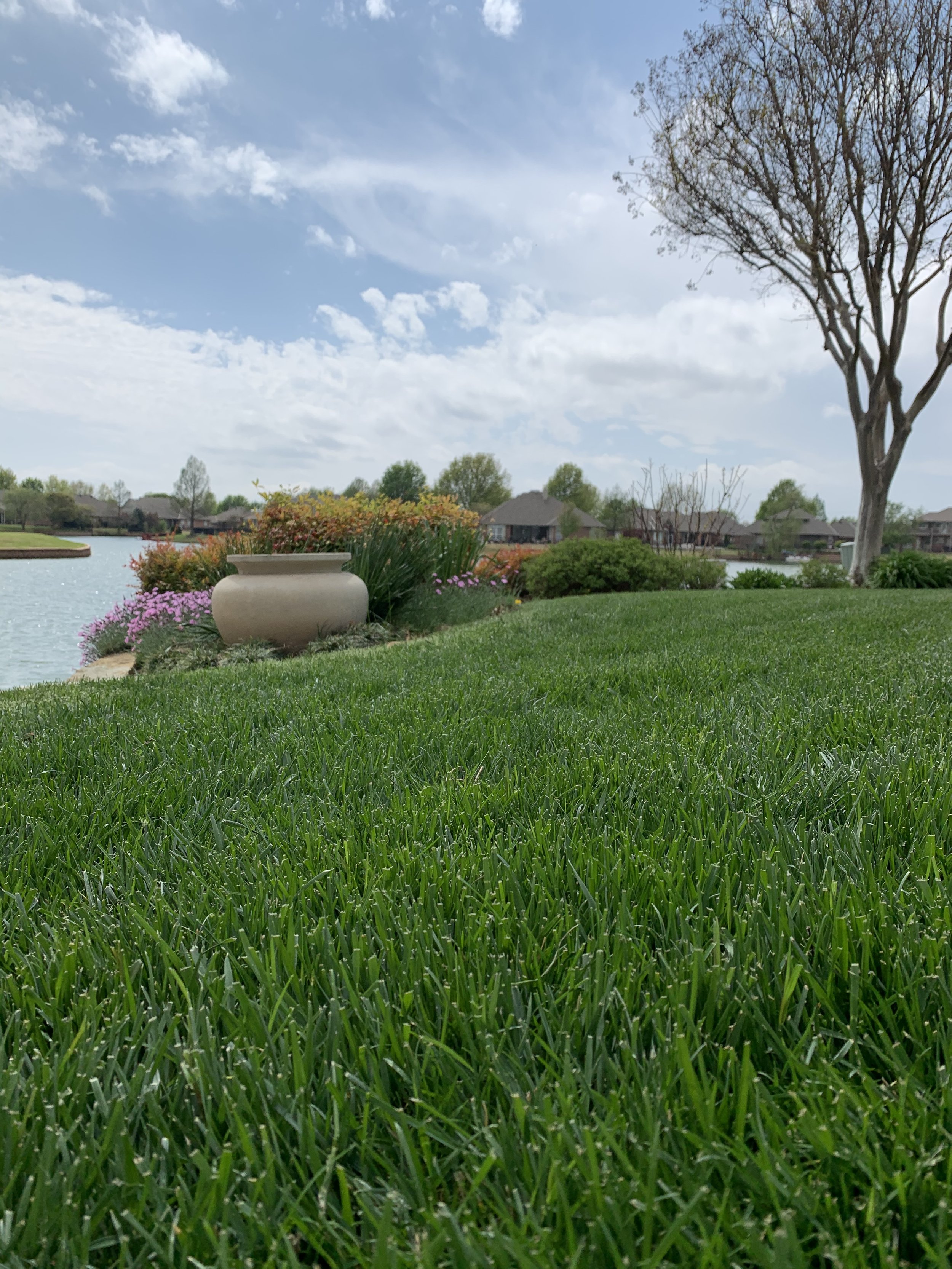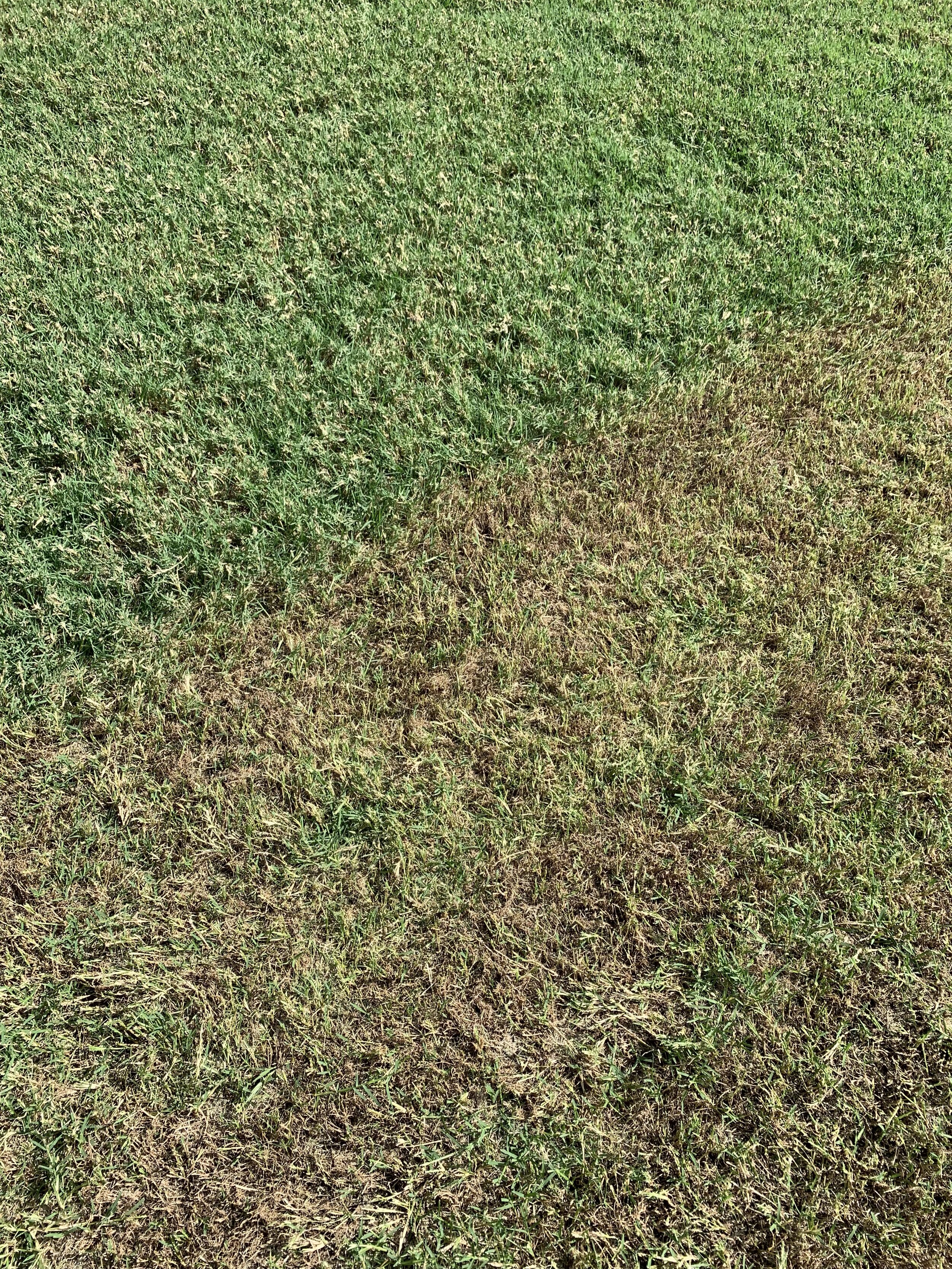Best Practices for Successfully Establishing Fescue
Have you noticed how much we have been talking about fescue lately?
On August 11th, we wrote about Bermuda vs Fescue – The Choice is Yours!
Last week in our September Lawn & Landscape Tips the first item we listed was Fescue Overseeding.
As the temperature cools and moisture returns, fescue lawns will regain cooler and health.
Small, shady areas in your lawn where there is low air movement and shade are prime candidates for annual fall seeding with fescue.
It has been common to find stressed areas of fescue from uneven water distribution this summer.
If you have heavily shaded areas it is common to need to overseed in the fall, regardless of the summer weather conditions.
Fescue is the best turf grass for areas of your lawn that receive dappled sun. Bermuda needs at least 6 hours per day of direct sun light.
Fescue is commonly thought of as a shade grass. But fescue grown using the best maintenance and lawn care practices can thrive in full sun.
Why so much focus on fescue?
Because, you are asking a lot of questions about fescue…
& because, it is the best time to establish a fescue lawn!
It has been a stressful summer for fescue areas with uneven water distribution. Fall is the best time to overseed any damaged areas of fescue.
Who should plan on overseeding with fescue this fall?
If you have areas of your lawn where the bermuda has thinned because of shade, you should seed this fall. Bermuda needs at least 6 hours of direct sunlight for the best performance. Less than 6 hours of direct sunlight and bermuda starts to thin.
If you have fescue areas that have become thin because of brown patch or drought, you should seed this fall.
If you just want to keep your fescue thick and healthy, you should seed this fall. Fescue doesn’t spread like bermuda with runners across the top of the soil. Fescue spreads through tillering through the soil and putting up new vertical shoots. Fescue spread is slow and often rare in the transition zone in which we live. To keep a fescue lawn at it’s best, adding more seed is common. Our best fescue lawns are overseeded every fall.
If you want to have a green lawn longer into the fall and earlier in the spring, you should seed this fall. Fescue is a cool season grass and stays green and active into early December and recovers from the winter in early March. With a fescue lawn, it is common to have a green lawn 10 out of 12 months.
This fall is the best time to repair fescue areas that were damaged during this summer’s heat and drought.
Myth: It is difficult to grow fescue. But, really it isn’t. Growing fescue does require a different approach to your lawn, but it isn’t difficult when you follow the best practices for overseeding with fescue.
4 Best Practices for Successfully Establishing Fescue
Best Practice #1 – Seeding fescue in the fall.
Because fescue is a cool season grass, there are two times per year you can plant fescue seed; Fall (September through October) and Spring (March to early April).
If you wait until spring to seed fescue, you are seeding at the second-best time and there is an enormous chasm between the establishment of fescue now (the best time) and next spring (the second-best time).
Spring seeded fescue will come up great, but it rarely establishes enough root system to make it through the summer heat (fescue’s off season).
Fall seeded fescue has all fall, winter, and spring to establish a root system before enduring the heat of July and August.
Don’t fail at establishing fescue – seed in the fall, not the spring.
Best Practice #1 – Seeding fescue in the fall.
Best Practice #2 – Good Seed to Soil Contact
Good seed to soil contact is important. If you sow seed over the existing soil without some preparation, the chance of a successful seeding is greatly reduced. Research shows the percentage of germination decreases dramatically when seed is just sown on top of the ground.
You will have success if you start by cutting the existing turf short to remove excess grass. Then loosen the soil to create good seed to soil contact.
This bermuda lawn is being cut short in preparation of overseeding it with fescue for the first time.
The lawn was being maintained at 3”.
Cutting it to 2” will improve the seed to soil contact and increase the success of the first time overseed.
Aeration is an important step in establishing good seed to soil contact. Good seed to soil contact and keeping the area moist are two keys two keys to success seeding.
Aeration is the best method to loosen the soil and gain good seed to soil contact. Aerating also gives you the extra benefit of improving the soil structure, increasing water absorption, and developing deeper roots.
Give more attention to bare areas and the edges. Rough up the areas with a rake.
Rototilling isn’t necessary, but breaking the surface of the soil in bare areas is needed.
In areas that are completely bare, spread a thin layer of peat moss over the surface after seeding to increase the seed to soil contact.
If overseeding an existing fescue area with a good stand of grass, spread seed at a rate of 6-8 pounds per 1,000 square feet.
If establishing a new fescue lawn, spread seed at a rate of 10-12 pounds per 1,000 square feet.
Best Practice #2 – Good Seed to Soil Contact
Best Practice #3 – Keep the Seed Tacky Moist Until It Germinates
The first two are very important, but this one is critical for success.
Nothing will deliver you a losing hand quicker than not keeping the seed moist. You can get the first two best practices correct and have complete failure if the seeded area is not kept moist until new grass is visible in the entire area.
Even water distribution is important in keeping the seed tacky moist until it comes up. Check your system. Look for areas where there isn’t complete head to head coverage. The result will be poor germinate around the sprinkler head.
This picture 14 days after seeding demonstrates how critical moisture is to seed germination. The seed in the area where the irrigation does not reach has not germinated at all while the moist areas are nearly fully germinated.
When you keep the seeded area consistently tacky moist you will seed germination within 7-14 days. Best practice is to water the area 3 short cycles per day.
The worst thing you can do is water the seeded area, allow it to dry completely, water again, allow it to dry completely, repeat, repeat, repeat… After a couple of times of drying out completely, the seed will no longer be viable.
For the best success, set your irrigation to run 3 short cycles per day. Set spray type zones to run 3-5 minutes each time. Set rotor type zones to run 7-10 minutes each time. If possible, set the system to run early morning (4:00 AM), late morning (10:00 AM), and mid-afternoon (4:00 PM).
You don’t have to have an irrigation system to establish fescue. Just be diligent at watering every morning and every evening.
Best Practice #3 – Keep the Seed Tacky Moist Until It Germinates
Best Practice #4 – Invest in a Quality Seed
Fescue was first introduced in the US from Europe in the 1800s as a pasture grass. Kentucky-31 Tall Fescue was developed in the 1940s as an improved pasture grass and introduced to the home turf market in the 1960s by Pennington Seed.
Improved fescue varieties are very heat and drought tolerant and can successfully be grown in full sun.
What is the point of the seed history lesson?
If you are buying Kentucky-31 Tall Fescue, you are buying an 80-year-old product when there are over 300 improved fescue varieties that offer darker green color, narrower blades, and improved tolerance to heat, cold, drought, and disease. Kentucky-31 is marginally acceptable as a lawn grass that tends to become thin and clumpy.
No matter the name on the bag of the seed, any improved variety will outperform Kentucky-31.
We believe using a blend is best when seeding fescue. Blends are a combination of two or more varieties within the same species, such as two or more fescues in one mix. Blends are a combination of the best species, tested over time, for the best shade tolerance and disease resistance. The number one problem with fescue is brown patch disease. The best blends use fescue varieties that show strong resistance to brown patch. Also, some blends will contain bluegrass and, or rye for even more vibrant spring color.
Best Practice #4 – Invest in a Quality Seed
All seed grown in Oregon is certified. Buy it when possible.
When purchasing seed look for a blend with fescue varieties that score high in the NTEP trials for heat, drought, and disease resistance.
Two things that will make a seed more expensive, but at the same time a great value, “0% Weed Seed” and “Treated with Gravity SL PGS”.
Gravity SL PGS is a growth stimulant that greatly increases germination rates and root development.
Fescue can be grown successfully in Oklahoma. Even during a hot and dry summer, there are examples of great fescue lawns in every neighborhood. And for the fescue lawns that showed stress this summer, surprisingly most will show signs of a rebound with slightly cooler temperatures and moisture.
Successful fescue lawns are the result of best seeding practices, best cool season turf maintenance practices, and persistence.
But, more importantly, they are a result of different thinking. Establishing and maintaining a fescue lawn requires a different approach.
Bonus Best Practice
Don’t apply a fall pre-emergent before seeding. The same pre-emergent herbicide that prevents weeds will prevent fescue from germinating. Wait until after the new fescue has been mowed 2-3 times before putting a pre-emergent on the lawn.
Special Note: DO NOT use pre-emergent herbicides now in areas that are going to be seeded this fall.
If you need assistance in establishing a fescue lawn or have questions about fescue, give us a call – (405) 367-3873.
Lorne Hall
Hall | Stewart Lawn + Landscape
(405)367-3873
























